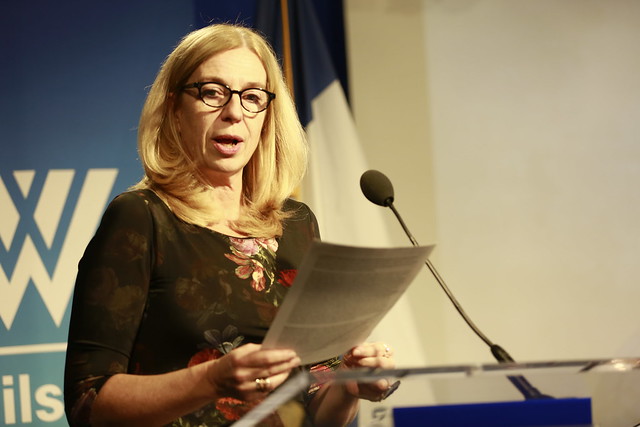-
The 30th Anniversary of the Safe Motherhood Initiative
January 4, 2018 By Sarah B. Barnes
Since 1987, the number of women dying during pregnancy and delivery has dropped by 43 percent, saving hundreds of thousands of women’s lives—and changing the lives of their families—around the world. “Our achievement in making maternal mortality an injustice that needs to be recognized by health ministers, by heads of state, by heads of agencies, has been, I think, the single greatest achievement of the Safe Motherhood Initiative” since it began 30 years ago, said Ann Starrs, President and CEO of Guttmacher Institute, at a Wilson Center event marking the anniversary of this important effort.
Yet the work is not done: “Every day, 800 women die; [there are] 7,100 stillbirths, and 7,000 newborns die,” said researcher Barbara Kwast, one of the early pioneers of the movement. “Twenty years in Africa have shown me so many maternal deaths,” she said. “Women shouldn’t die giving life. Women are not pregnant nine months to have a stillbirth at the end.”
The Birth of Safe Motherhood
“The genesis of safe motherhood was a birth process in itself,” said Kwast. Since the 1987 conference in Nairobi that launched the movement, “we’ve seen tremendous evolution in the issue of maternal health, in the language that we use to talk about it,” said Starrs. “It’s striking how mainstream, how integrated the issue of maternal health is now”; today, it is “an issue of human rights, equity, and social justice.”
Once neglected by the global health community, maternal health has become a prominent part of the international development agenda and included in the Millennium Development Goals and the Sustainable Development Goals. But even with this global attention, USAID Senior Maternal Health Advisor Mary Ellen Stanton cautioned, “the changing landscape will profoundly affect what happens in countries and what we can do. Maintaining momentum is not going to be enough. We are going to need to do more.”
Meeting the Challenge: Midwives and Family Planning
Even though the maternal mortality rate has recently increased in the United States, 99 percent of maternal deaths still happen in developing countries. “In sub-Saharan Africa, the risk of a woman dying due to pregnancy-related issues is 100 times the risk in the U.S.,” said Stanton. There are some success stories; for example, both Malawi and Ethiopia have cut their country’s maternal mortality rates by half. But as Address Malata, Vice Chancellor at Malawi University of Science and Technology, said about Malawi, “it is now 439 [deaths per 100,000]. Can we really celebrate? I don’t think it’s good enough.”
The shortage of highly trained midwives in sub-Saharan Africa is a major challenge. In Ethiopia, for example, only 28 percent of women deliver with a skilled birth attendant. “Let’s invest in midwifery education, build more schools, properly educate teachers,” said Malata. And the investment needs to come not just from governments, but also the private sector, said Etiebet.
Access to contraception is also critical to preventing maternal mortality because “without pregnancy, there would be no maternal death,” said UNFPA Midwife Advisor Dorothy Lazaro. More than 200 million women still have an unmet need to modern contraception, and women in remote areas of developing countries can spend days traveling to district health facilities, only to find their preferred method of contraception is unavailable. “Think about what impact that is having on their behavior, on their decision making,” said Mary-Ann Etiebet, Executive Director of Merck for Mothers.
“Political leaders must have multi-sectoral approaches to maternal health” in order to meet these diverse challenges that block progress on reducing maternal mortality, said White Ribbon Alliance CEO Betsy McCallon. “Political will and leadership can change the game,” added Malata.
The Faces Behind the Numbers
Maternal mortality “is a measureable indicator of the lack of value placed on women’s lives,” said McCallon. “We must work for the right for all to be treated with dignity and respect.”
To improve maternal health, care must not only be respectful, it must be women-centered. “It’s midwives, it’s our nurses, it’s our doctors, it’s our families that are taking care of women—and unless we invite them in and we listen to them…and their input is integrated into solutions, we’re not going to hit our goals,” said Etiebet.
But the 308,000 women dying each year due to complications in pregnancy and delivery are not simply data points. “When you have looked into the panic-stricken eyes of a woman dying on the labor ward floor,” said Kwast, “then behind these numbers, there are faces.”
Photo Credit: Mothers wait to vaccinate their babies in Mali, November 2013, courtesy of the World Bank.
Sources: British Medical Bulletin, Guttmacher Institute, Malawi University of Science and Technology (MUST), Merck for Mothers, New York Times, White Ribbon Alliance, World Health Organization (WHO)
Subscribe:







